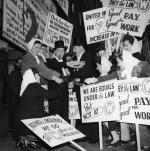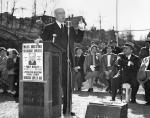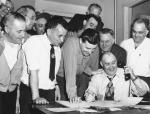![header=[Marker Text] body=[Chief Steward and President, United Electrical Workers Union Local 506, 1942-1959. Accused of McCarthy-era Communist activity, he was the first union leader fired by General Electric, 1953. Nelson defended civil rights while UE represented him in court. He died prematurely at 42.] sign](http://explorepahistory.com/kora/files/1/10/1-A-BF-139-ExplorePAHistory-a0m9h8-a_450.jpg)
Mouse over for marker text
Name:
John Nelson 1917-1959
Region:
Lake Erie Region
County:
Erie
Marker Location:
UE 506 Union Hall, 3923 Main Street, Erie PA
Dedication Date:
September 18, 2004
Behind the Marker
In the 1930s, many Americans had blamed the free-market system for the Great Depression. As the depression dragged on, significant numbers of American farmers, industrial workers, intellectuals, students, and others, were attracted to Socialism and Communism, which appeared to offer an attractive alternative to the failed free market system.
A home to many large and small electrical manufacturing shops, Pennsylvania became a critical battleground between left- and right-wing forces for control of the national union. The major fight in Pennsylvania centered on the East Pittsburgh plant of Westinghouse Electric, where bitterly contested elections and heavy involvement by Father Charles Owen Rice and other Catholic unionists precipitated a split in the UE and its expulsion from the CIO.
CIO.
Following the Second World War, the governments at state and federal levels gradually dropped wartime restrictions on the production of consumer goods and on wage increases, which spurred American workers to unleash a new wave of union battles for better conditions and benefits. In fact, the 1940s and 1950s became the high-water mark of American unionism.
In 1946, the electrical, steel, and auto industries experienced the greatest wave of strikes in American history. These job actions helped American workers achieve major improvements in working conditions and higher wages, which contributed, in turn, to a major boost in national consumption, production, and thus prosperity. But the strikes also led to a political backlash, as conservatives in Congress in 1947 won enough support from moderates to pass the Taft-Hartley Act, which considerably weakened the legal protections that American workers had won in the path-breaking Wagner Act of 1935.
In the late 1940s, the United States also entered its long and dangerous Cold War with the Soviet Union. One of the Taft-Hartley Act's provisions required union officials to sign affidavits that they were not a "member of the Communist Party nor affiliated with such a party." Initially, many unions fought the affidavits and their union officials refused to sign, arguing that they were an attack on civil liberties. As American anti-communist hysteria continued to mount, however, the unions caved. By 1949, even officials of the United Electrical, Radio and Machine Workers Union (UE), one of the nation's more progressive unions, signed affidavits as rival unions intensified raids on their locals.
Elected chief steward in 1940 and then president in 1942, John Nelson was the charismatic leader of the militant, younger workers inside Local 506, which represented the more than 10,000 employees of the vast General Electric locomotive plant in Erie. In 1943, Nelson left to serve with the army in Germany. Again elected union president upon his return from the service in 1945, he led the union during the strike of 1946, and helped hold the workers together when other electrical workers' locals were being split by religious and political differences.
Erie. In 1943, Nelson left to serve with the army in Germany. Again elected union president upon his return from the service in 1945, he led the union during the strike of 1946, and helped hold the workers together when other electrical workers' locals were being split by religious and political differences.
This commitment to political tolerance received a major boost from the relatively conservative, first president and elder statesman of the local, James Kennedy. Replying to persons who accused the UE of harboring Communists, Kennedy pointed to the union's constitution, which opened membership to all electrical workers regardless of race, sex, religion, craft, or political belief.
"Can anyone take exception to this and consider themselves an American?" Kennedy asked during the height of the struggle. Nationally, however, divisions within the CIO increased as the Berlin blockade fueled Cold War tensions. When the UE supported Progressive Party candidate Henry Wallace for President, over Democrat Harry Truman in the presidential election of 1948, CIO president Phillip Murray resolved to either to take over or expel the UE.
In the fall of 1949, the UE split from the CIO, which then formed a rival organization, the International Union of Electrical Workers (IUE), which began raiding the UE. In 1950, the IUE branded Nelson as a Communist in an unsuccessful attempt to replace the UE as collective-bargaining representative of the Erie workers. Nelson, a devout Catholic who had spent two years in the seminary studying for the priesthood, successfully deflected the anti-Communist Catholic clergy's attacks on the union. But he was not immune from attacks by Senator Joseph McCarthy of Wisconsin, who as chairman of the Senate Internal Security Sub-Committee led the anti-Communist purges then taking place in Washington, D.C., and around the nation.
Pressured by McCarthy, General Electric, under the leadership of its president Ralph Cordiner, instituted a policy to fire employees who the company believed had failed to clear themselves of charges of Communist affiliation. In 1954, Nelson became the first of twenty-eight activists that GE fired under the so-called Cordiner doctrine. For the next six years, Nelson and the UE fought GE to restore his job. The national union defended his civil rights in court while his union local made the presidency a full-time position to protect his employment. Only forty-two years old, Nelson died in 1959-after he had again been forced to testify before the House Un-American Activities Committee -his health undermined by the attacks on himself and his family.
House Un-American Activities Committee -his health undermined by the attacks on himself and his family.
The anti-Communist witch hunts of the 1950s split the once large and powerful electrical-workers union. While the UE survived, its membership, and that of the rival UIE dropped significantly. The Red Scare had a profound impact on the labor movement in the United States, and especially in Pennsylvania. After the reuniting of the house of labor in 1955 under the merged AFL-CIO, the American labor movement reached its peak in numbers, but it had also become much more conservative and far less critical of the operation of the American free-market system.
Once a mighty vehicle for reform and progressive legislation, the labor movement began its slow but steady slide toward a conservative and largely defensive attitude. Union support for the Vietnam War and alienation from the civil rights, women's movement, and environmental movement led to its relative political isolation when the unionized manufacturing sector began its collapse in the 1970s, and powerful national forces became increasingly anti-union. In Pennsylvania, the electrical workers remained divided until the collapse of the Pennsylvania electrical industry in the 1980s.
A home to many large and small electrical manufacturing shops, Pennsylvania became a critical battleground between left- and right-wing forces for control of the national union. The major fight in Pennsylvania centered on the East Pittsburgh plant of Westinghouse Electric, where bitterly contested elections and heavy involvement by Father Charles Owen Rice and other Catholic unionists precipitated a split in the UE and its expulsion from the
Following the Second World War, the governments at state and federal levels gradually dropped wartime restrictions on the production of consumer goods and on wage increases, which spurred American workers to unleash a new wave of union battles for better conditions and benefits. In fact, the 1940s and 1950s became the high-water mark of American unionism.
In 1946, the electrical, steel, and auto industries experienced the greatest wave of strikes in American history. These job actions helped American workers achieve major improvements in working conditions and higher wages, which contributed, in turn, to a major boost in national consumption, production, and thus prosperity. But the strikes also led to a political backlash, as conservatives in Congress in 1947 won enough support from moderates to pass the Taft-Hartley Act, which considerably weakened the legal protections that American workers had won in the path-breaking Wagner Act of 1935.
In the late 1940s, the United States also entered its long and dangerous Cold War with the Soviet Union. One of the Taft-Hartley Act's provisions required union officials to sign affidavits that they were not a "member of the Communist Party nor affiliated with such a party." Initially, many unions fought the affidavits and their union officials refused to sign, arguing that they were an attack on civil liberties. As American anti-communist hysteria continued to mount, however, the unions caved. By 1949, even officials of the United Electrical, Radio and Machine Workers Union (UE), one of the nation's more progressive unions, signed affidavits as rival unions intensified raids on their locals.
Elected chief steward in 1940 and then president in 1942, John Nelson was the charismatic leader of the militant, younger workers inside Local 506, which represented the more than 10,000 employees of the vast General Electric locomotive plant in
This commitment to political tolerance received a major boost from the relatively conservative, first president and elder statesman of the local, James Kennedy. Replying to persons who accused the UE of harboring Communists, Kennedy pointed to the union's constitution, which opened membership to all electrical workers regardless of race, sex, religion, craft, or political belief.
"Can anyone take exception to this and consider themselves an American?" Kennedy asked during the height of the struggle. Nationally, however, divisions within the CIO increased as the Berlin blockade fueled Cold War tensions. When the UE supported Progressive Party candidate Henry Wallace for President, over Democrat Harry Truman in the presidential election of 1948, CIO president Phillip Murray resolved to either to take over or expel the UE.
In the fall of 1949, the UE split from the CIO, which then formed a rival organization, the International Union of Electrical Workers (IUE), which began raiding the UE. In 1950, the IUE branded Nelson as a Communist in an unsuccessful attempt to replace the UE as collective-bargaining representative of the Erie workers. Nelson, a devout Catholic who had spent two years in the seminary studying for the priesthood, successfully deflected the anti-Communist Catholic clergy's attacks on the union. But he was not immune from attacks by Senator Joseph McCarthy of Wisconsin, who as chairman of the Senate Internal Security Sub-Committee led the anti-Communist purges then taking place in Washington, D.C., and around the nation.
Pressured by McCarthy, General Electric, under the leadership of its president Ralph Cordiner, instituted a policy to fire employees who the company believed had failed to clear themselves of charges of Communist affiliation. In 1954, Nelson became the first of twenty-eight activists that GE fired under the so-called Cordiner doctrine. For the next six years, Nelson and the UE fought GE to restore his job. The national union defended his civil rights in court while his union local made the presidency a full-time position to protect his employment. Only forty-two years old, Nelson died in 1959-after he had again been forced to testify before the
The anti-Communist witch hunts of the 1950s split the once large and powerful electrical-workers union. While the UE survived, its membership, and that of the rival UIE dropped significantly. The Red Scare had a profound impact on the labor movement in the United States, and especially in Pennsylvania. After the reuniting of the house of labor in 1955 under the merged AFL-CIO, the American labor movement reached its peak in numbers, but it had also become much more conservative and far less critical of the operation of the American free-market system.
Once a mighty vehicle for reform and progressive legislation, the labor movement began its slow but steady slide toward a conservative and largely defensive attitude. Union support for the Vietnam War and alienation from the civil rights, women's movement, and environmental movement led to its relative political isolation when the unionized manufacturing sector began its collapse in the 1970s, and powerful national forces became increasingly anti-union. In Pennsylvania, the electrical workers remained divided until the collapse of the Pennsylvania electrical industry in the 1980s.
Beyond the Marker











